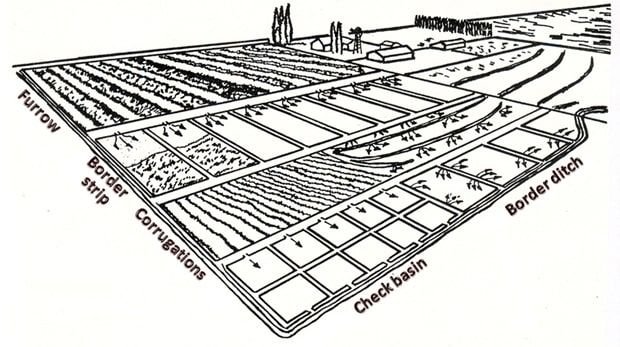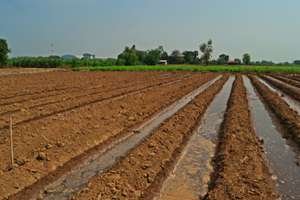What is furrow irrigation?
Furrow irrigation is a type of irrigation in which water is applied to furrows using small discharges to favour water infiltration while advancing down a field.
Gravitational pull is the driving force behind furrow (or ridge-furrow) irrigation. Ripples and furrows are used to direct water downhill through terraced fields. The most efficient conditions for using a furrow system are found on flat, easily graded ground.
However, this method is not advised for use on slopes or fields with undulations. When crops are raised atop ridges, water is directed into channels rather than pooling around the plant’s roots and stems, where it might cause rot or disease.
A wide variety of crops, particularly row crops, respond well to furrow irrigation. Furrows are an ideal way to water plants that would die if water accumulated at their crown or stem. Tree crops may also thrive with the help of furrow irrigation. One furrow beside the tree row may be adequate in the beginning, but as the trees grow, two or more furrows will be needed to provide enough water.
See also: What are the modern methods of irrigation?
Types of furrow irrigation
Straight furrow method of irrigation
Contour furrow method of irrigation
Corrugated furrow irrigation
Furrow irrigation: Slopes
For furrow irrigation, a uniformly level or gently sloping surface is ideal. This percentage must not go beyond 0.5%. After irrigation or heavy rain, a modest furrow slope of up to 0.05% is often supplied to aid drainage. Most soils are suitable for usage with furrows. However, like with other surface irrigation systems, excessively coarse sands are not advised since percolation losses might be considerable.
Erosion is an inevitable byproduct of furrow irrigation. The problem is made worse by the need for longer fields to boost agricultural productivity and the practice of “clean tillage,” which is essential for ensuring a constant and even stream of water through the furrow. Water is channelled via furrows that are 0.1 to 0.3 meters wide and are equally placed over fields that have a gradient of 0.1 to 3% using furrow irrigation.
Depending on furrow length, soil, water, and management factors, irrigation lasts 12–24 h. On steeper slopes (more than 1%), the flow rate must be carefully maintained to prevent soil erosion. Irrigation may need to last longer and have lower input rates, To get the necessary quantity of water into soils with a poor infiltration rate.
For these two main reasons, furrow irrigation has become the standard in many areas. They reduce the amount of money spent on irrigation while ensuring a bigger harvest.
When compared to other types of irrigation, furrow irrigation needs less money, less expertise, and more work. Since water may be channelled via furrows, fields can be watered without having to be graded or levelled.
Know about: surface irrigation
Furrow irrigation: Points to keep in mind
Soil aggregating capacity is the most important factor to consider while choosing soil for furrow irrigation projects. If it doesn’t soften too much when wet, it may be used for furrow irrigation. Sandier soils are the worst option since water won’t be controlled. It is safe to assume that furrow irrigation works well for most fruits and vegetables. When the roots require water but any touch with the stem or other portions would be harmful, this procedure is highly beneficial.
There is no standard practice for sloping fields for furrow irrigation. There still needs to be some tweaking done to account for the soil type. To best work with sandy soil, dig deep and make your furrows thin. The reason for this is that sandy soil is easier to penetrate than other types of soil. In contrast, deep and narrow furrows are recommended for sandy soil.
The rationale is that better wetting results from a greater quantity of water being in touch with the soil. Water retention may be improved by making the furrows wider and deeper in response to an increase in water flow.
The soil’s greatest and lowest slopes will establish the slope’s length. When working with a higher grade, a furrow may be made longer. If the soil is sandy, the furrow will be shallower. Very clay-like soil may be used as a base for building on top of it. It is recommended that the water flow be maintained at a rate of no more than three litres per second and no less than 0.5 litres per second to prevent soil erosion.
A furrow’s ability to store water increases with its depth, therefore a deeper furrow can support a greater volume of water and a longer irrigation system. When you need to cultivate your land regularly, consider cutting the furrows shorter. Depending on the dimensions of the field, it may be necessary to make minor adjustments to the recommended size.
Furrow irrigation: How to apply?
Building furrows on level or gently sloping ground:
- Ranging poles or chalk powder are used to draw lines in the field.
- Straight ridge movement occurs along the outlined path. The field has to be plowed again if it is not straight.
- Every five meters, new parallel lines should be drawn. Using a ridge-drawbar attached to a tractor, you can create four parallel furrows in one pass.
Building a furrow on sloping or undulating ground:
- At first, using a levelling instrument to find the contour line, direct the furrow along the top border of the field, not too far from the farm channel.
- More specifically, guide furrows are established every five meters on undulating terrain and every ten meters on uniformly sloped land.
- Halfway to the next guide furrow, furrows are dug.

Source: Pinterest
See also: Know about types of irrigation
Furrow irrigation advantages
- A large area may be irrigated rapidly.
- Efficient means of reducing time and effort expended.
- The low initial outlay for necessary equipment.
- The small amount of water lost in the gravity irrigation system makes this a very cost-effective strategy.
- Savings may be realised due to the reduced per-unit cost of pumped water.
- There is a way to reuse the water that is lost during irrigation.
- Furrow irrigation has the potential to reduce the number of chemicals leaching into the environment significantly.
Furrow irrigation disadvantages
Not suitable for sandy soil.
Not suitable for some crops.
Hassle maintaining water flow.
Salt accumulation in ridges of soil between the furrows.
Difficulty in the movement of farm equipment.
Higher labor cost.
FAQs
Can water be conserved by using furrow irrigation?
Drip irrigation is 90% efficient in conserving water, whereas furrow irrigation is 50% efficient.
Can soil erosion be slowed by using furrow irrigation?
Irrigation depletes soil and nutrients. Alternate furrow irrigation reduces soil-to-water contact and erosion. It is not uncommon for the second round of irrigation to reach the furrow that was missed the first time.
Can you recommend any crops that do well with furrow irrigation?
Furrow irrigation works well for row crops like tomatoes, cabbages, green vegetables, sugarcane, and sweetcorn.
Housing News Desk is the news desk of leading online real estate portal, Housing.com. Housing News Desk focuses on a variety of topics such as real estate laws, taxes, current news, property trends, home loans, rentals, décor, green homes, home improvement, etc. The main objective of the news desk, is to cover the real estate sector from the perspective of providing information that is useful to the end-user.
Facebook: https://www.facebook.com/housing.com/
Twitter: https://twitter.com/Housing
Email: [email protected]











